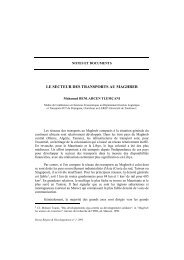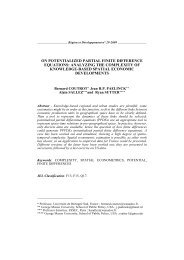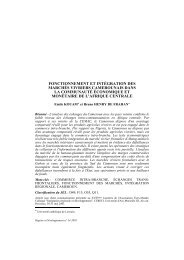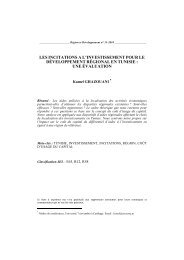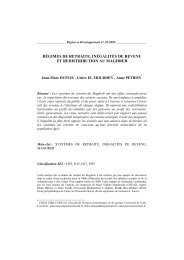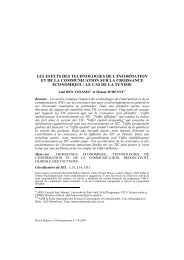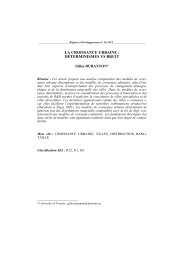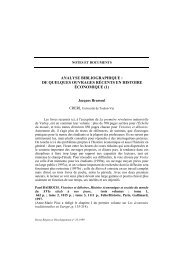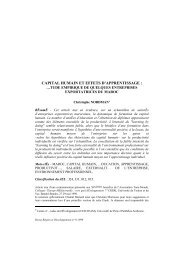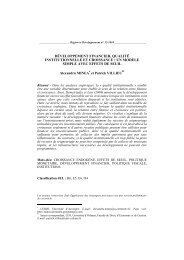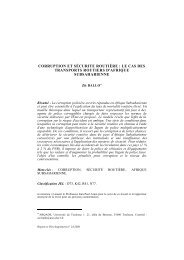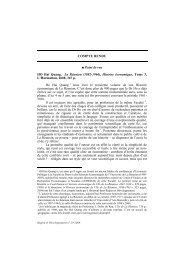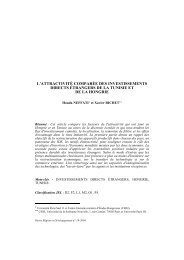space and growth: a survey of empirical evidence ... - ResearchGate
space and growth: a survey of empirical evidence ... - ResearchGate
space and growth: a survey of empirical evidence ... - ResearchGate
You also want an ePaper? Increase the reach of your titles
YUMPU automatically turns print PDFs into web optimized ePapers that Google loves.
20 Maria Abreu, Henri L.F. de Groot <strong>and</strong> Raymond J.G.M. Florax(1995), who argue that productivity is a function <strong>of</strong> both domestic <strong>and</strong> foreignR&D, with the latter spilling over through trade. Focusing on the 22 OECDcountries that conduct the bulk <strong>of</strong> the world's R&D, the authors constructmeasures <strong>of</strong> the domestic R&D stock using accumulated R&D expenditures, <strong>and</strong>measures <strong>of</strong> the foreign R&D stock using trade-weighted measures <strong>of</strong> the R&Dstocks <strong>of</strong> each country's trade partners. In this way the authors give more weightto R&D spillovers from countries that are located relatively close in terms <strong>of</strong>bilateral trade (<strong>and</strong> indirectly in terms <strong>of</strong> physical distance, since trade is afunction <strong>of</strong> physical distance). The results indicate that R&D spillovers aresubstantial. In a follow up to this paper, Coe et al. (1997) extend the analysis tostudy R&D spillovers from the OECD countries to a large number <strong>of</strong> lessdevelopedcountries. The results indicate that R&D spillovers from industrializedcountries to less-developed countries are substantial. Keller (2002) alsoexamines the effect <strong>of</strong> foreign R&D on domestic productivity, using data disaggregatedby industry for a sample <strong>of</strong> OECD countries. In order to test whethertechnology diffusion is local or global in scope, the foreign R&D term in themodel is weighted by an exponential distance decay function. Estimation resultsconfirm that technology spillovers are declining with physical distance. Theresults also indicate that sharing a common language facilitates technologydiffusion, <strong>and</strong> that technology spillovers are becoming less localized over time.Other studies <strong>of</strong> spillovers within the non-spatial econometrics literaturehave mostly focused on the effects <strong>of</strong> political instability in neighboringcountries. Ades <strong>and</strong> Chua (1997) find that regional instability (defined as theaverage number <strong>of</strong> coups <strong>and</strong> revolutions in neighboring countries) has a negativeeffect on <strong>growth</strong>. Murdoch <strong>and</strong> S<strong>and</strong>ler (2004) find that a civil war within adistance <strong>of</strong> 800 km can have a negative effect on <strong>growth</strong>.One advantage <strong>of</strong> using spatial econometrics to estimate models <strong>of</strong>technology diffusion <strong>and</strong> spillovers is that spatial relationships are summarizedin a spatial weights matrix. This allows the estimation <strong>of</strong> more complex models<strong>of</strong> spatial heterogeneity <strong>and</strong> spatial dependence. However, there is also a relateddisadvantage, which is that the spatial weights matrix (<strong>and</strong> by extension therelationships between countries) must be exogenous <strong>and</strong> in cross-section modelsit should be invariant over time. This precludes using trade, foreign directinvestment or measures <strong>of</strong> cultural distance as spatial weights. One possiblesolution could be the use <strong>of</strong> geostatistical models (discussed in Section 3), butmost studies <strong>of</strong> <strong>growth</strong> using spatial econometrics have focused on physicaldistance as a measure <strong>of</strong> the strength <strong>of</strong> bilateral ties. Interestingly, Keller (2002)uses physical distance to capture bilateral ties in order to avoid focusing on onechannel <strong>of</strong> technology diffusion. Trade, foreign direct investment, <strong>and</strong> contactsbetween researchers have all been shown to be a function <strong>of</strong> physical distance inthe <strong>empirical</strong> literature. There may thus be an additional methodological reasonfor focusing on bilateral relationships measured in terms <strong>of</strong> physical distance.




